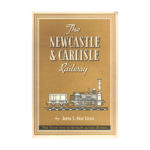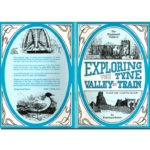Description
I have been unable to identify “H.U.S”.
The Newcastle & Carlisle Railway (N&CR) had a long gestation period, originating as a canal but proposed as a railway company formed in 1825 to build the first line crossing Britain from east coast to west coast. Construction also occupied a lengthy period. It began operating mineral trains in 1834 between Blaydon and Hexham, and passengers were carried for the first time the following year. Embarrassment resulted when the first trains began operating, and it was pointed out by a local landowner that its Act of Parliament prohibited the use of steam locomotives…The rest of the line opened in stages, completing a through route between Carlisle and Gateshead, south of the River Tyne in 1837. The directors repeatedly changed their intentions for the route at the eastern end of the line, but finally a line opened from Scotswood to a Newcastle terminal in 1839. That line was extended twice, reaching Newcastle Central station in 1851.
Despite connecting with other railways at each end, for many years the line ran trains on the right-hand track on double line sections, until absobed by the North Eastern Railway in 1862. An earlier flirtation with the Maryport & Carlisle Railway in the form of a working agreement might have had interesting consequences for the railway geography of northern England had amalgamation resulted. The mighty London & North Western would have viewed the resulting railway as far too tempting a target for take over, giving as it would have done, access to north west Cumbrian iron ore , and the rich coal fields of the north east.
The historical and archaeological information relating to the Roman remains reflects the state of knowledge in 1851, and has been superseded by research and excavations carried out since then.
The growth of the railway network in the 1840’s and 1850’s stimulated the publication of many local rail guides of this type, which in turn encourage tourism amongst a much wider section of the population.





Reviews
There are no reviews yet.